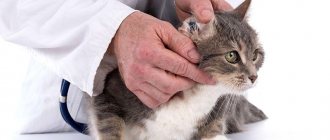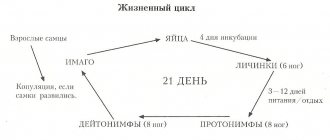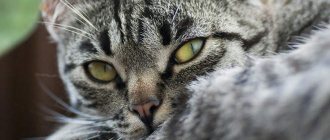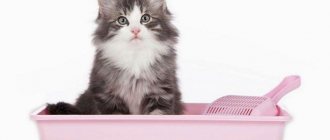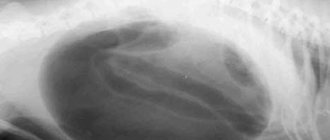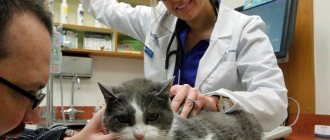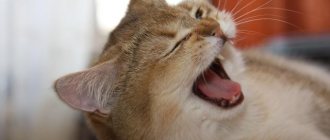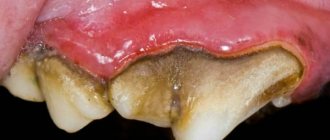To quench daily thirst, in normal condition a cat needs 30 ml of water per 1 kg of weight. These statistics apply only to healthy animals whose lives are not in danger.
When dehydration occurs in a cat’s body, it may not only be a matter of restoring the water balance, but it is a fact that the tailed friend will need help as quickly as possible. Because when there is an acute shortage of water, representatives of the cat family die within a few hours. The owner’s task is to determine in time that the animal needs help and provide appropriate treatment and proper care.
Dehydration – what is it?
Dehydration in a cat is a lack of water in the body. This is a serious problem that threatens the normal functioning of the organs of an animal whose body is 2/3 water. Receiving 10% less moisture, the pet already feels unwell, and with a loss of 20%, without taking measures, death is possible.
Estimating and measuring the volume of water a cat drinks per day is a rather difficult task. However, if she stops drinking or comes to water less often than before, Murkoshi employees advise paying attention to this. Perhaps your pet has a concomitant disease and needs help from a veterinarian.
Necessary treatment
The main goal of therapy is to replenish the missing fluid in the cat’s body. Some owners are confident that they can restore their pet at home with their own efforts. But it is important to understand that dehydration is a serious problem and requires urgent contact with a veterinarian, as it can lead to complications and death of the animal. If the cat frequently defecates or constantly vomits, then it is necessary to urgently replenish the water balance. Glucose, which must be injected subcutaneously into the withers, helps eliminate the symptoms of dehydration in your pet. A solution of sodium chloride or “Gamavit” is used in a similar way.
If a dehydrated pet is in critical condition, it should be treated at a veterinary clinic. The patient is prescribed a drip with special solutions that restore the function of many internal organs and systems. When the problem is related to poisoning, additional sorbents are prescribed that remove toxic substances from the cat’s body. The following useful drugs are identified:
If the symptom is caused by poisoning, then the animal can be given Enterosgel.
- Activated carbon;
- "Smecta";
- "Enterosgel".
It is important to constantly water your cat so that its condition does not worsen. If dehydration is mild and your pet refuses fluid, you can try giving it through injections (without a needle), injecting water directly into the pet’s mouth. In advanced cases, it is possible to cure a cat only in a hospital setting, where he will be under the constant supervision of a veterinarian and, if his condition rapidly deteriorates, he will be given the necessary assistance.
Causes of dehydration in cats
According to Roald Dahl, “cats know what they are doing. You will never meet a cat who would do something that he does not want. Anyone but them." Sometimes the lack of water is not the choice of the animal, but the mistake of its owner, who forgot to fill the drinking bowl in the morning. In addition, the causes of dehydration in a cat will be:
- poisoning and viruses - since they are often accompanied by diarrhea and vomiting, which contribute to the rapid loss of fluid and leaching of beneficial microelements from the body; - chronic diseases or age-related changes - over time, the cat’s kidneys begin to function worse and their ability to concentrate urine decreases. It may also be associated with renal failure, including chronic. This disease causes increased thirst, which is not enough to replenish the loss of moisture due to improper functioning of the kidneys;
Read more about this disease: Treatment of chronic renal failure in cats
- lack of water - if a cat eats only dry food, then it should always have a bowl of clean fresh water, or better yet several, freely available; - heatstroke - it threatens a cat who is outside for a long time on a hot day or under the scorching sun; - injuries and heavy hemorrhages ; — fever – often accompanies various serious diseases; - staying in an unventilated, stuffy room; - stale or spoiled (poisoned) food; - prolonged stress - a state of shock or excitement, especially long-term, has a negative effect on the animal’s body, causing the development of many diseases, including dehydration in kittens and cats. Babies are more susceptible to stress than adults, because they are taken away from their mother, sisters and brothers, and there is a lot of unknown around them. The owner needs to make sure that from the first days of life in the new family the kitten feels cared for and calm.
Often the reason that a pet doesn’t drink enough is because the water bowl is located in an inconvenient place or too close to the food.
Read more: What should a cat's water bowl be like?
Preventive measures
You can prevent your pet from becoming dehydrated. To do this you need to follow simple steps:
- contact a veterinarian if your animal’s behavior changes, which will help prevent severe dehydration;
- feed the cat dry food when the pet receives the required amount of liquid (water can be added directly to the dry food);
- ensuring round-the-clock access to drinking water.
It is recommended to change the water every day. Some cats prefer running water rather than liquid in a bowl. For such pets, you need to purchase a special drinking fountain filled with water.
Signs and consequences
The danger of dehydration in cats lies in the fact that at the first stage it is difficult to notice the symptoms of the disease. When it progresses, the animal can die within 24 hours. To save him, emergency care will be required at a veterinary clinic.
There are three forms of dehydration:
1. Mild (water deficiency less than 5%) – the animal’s activity decreases slightly, the nose becomes warm and dry (this is normal only immediately after sleep, in a healthy cat it is cool and moist). 2. Moderate (5-10% deficiency) – the oral mucosa turns pale, saliva becomes thick and sticky. 3. Severe (deficit more than 10%) – signs of mild and moderate forms + general lethargy, refusal to eat, poor sleep, desire to be away from loud sounds and bright lights.
Volunteers of “Murkoshi” pay attention: if vomiting, diarrhea and refusal to eat are present at the same time, the animal has been dehydrated for about 8-12 hours, it must be urgently shown to a veterinarian.
Signs that help identify dehydration in kittens:
- sunken eyes; - arrhythmia; - dry skin and mucous membranes; - lethargic and depressed state; - decreased or lack of appetite; - constipation or, conversely, diarrhea; - viscous, viscous saliva; - gums of a light shade.
Symptoms
Symptoms of dehydration can vary and depend on several factors and the underlying underlying cause that caused the fluid and electrolyte imbalance. The simplest test a cat owner can perform to determine possible dehydration is to check the elasticity of the skin.
You need to grab a fold of your pet's skin with your index finger and thumb and release. Normal skin turgor allows it to return to its original appearance instantly. When smoothing the skin for more than five seconds, we can talk about the presence of dehydration.
It is better to take the skin in the area of the shoulder blades (withers) for the test. It is extremely important to note the condition of the visible mucous membranes. Thus, the saliva released from the oral cavity should be of a liquid consistency. As dehydration develops, saliva becomes viscous and thick.
Signs of dehydration include infrequent trips to the toilet. Violation of the act of urination indicates a large number of pathologies, mainly associated with the urinary system. The development of dehydration is also accompanied by a decrease in the number of acts of urination.
If there is no urine output, it is necessary to show the animal to a veterinarian. This is due to the fact that the absence of urination can be caused by urinary retention with a full bladder due to blockage of the urethra.
How to cure a cat
At the first signs of dehydration in a cat, you must immediately take measures to restore the balance of fluid in his body. To do this, the pet is moved to a cool place and a drinking bowl with water is placed next to it. If there is no vomiting, but the cat still does not drink, you need to try pouring water or a solution of water, salt and sugar into his mouth using a syringe without a needle.
If the pet is vomiting, inject 10 ml of glucose or sodium chloride solution and an additional 1 ml of Gamavit. These actions will provide first aid and save you from loss of water and useful minerals. But the main thing is to get the cat to the vet on time. The doctor prescribes medications:
- to maintain cardiac functions (cordiamin, caffeine) - due to a lack of fluid, the blood thickens and the work of the “flame motor” becomes difficult; - to suppress the urge to vomit (Cerucal) - so that water and medicine are retained in the stomach.
Features of treatment
They begin to treat a dehydrated cat’s body only after determining the causes of the pathological condition. To cure your pet, you need to use the help of a veterinary clinic. Dehydration does not appear just like that; this condition is considered a sign of serious illness. Therapy is aimed at eliminating the causes of dehydration.
Experienced clinic specialists will conduct research, establish a diagnosis, and prescribe the correct treatment for dehydration. Prompt treatment ensures that there are no serious or severe consequences.
Mild forms of dehydration go away faster if you follow a home regimen. The cat needs to be given water from a syringe and the required amount of water is poured into the mouth.
With moderate and severe forms of dehydration, treatment of cats becomes more complicated. Animals' bodies are infused intravenously or subcutaneously. The cat is administered electrolyte solutions in the form of rehydron, glucose and other medications.
It is imperative to eliminate the cause of dehydration:
- the cat is given absorbents (for example, activated carbon) when dehydration was caused by poisoning;
- if parasites are detected, it is recommended to treat the pet with anthelmintic drugs;
- Antibiotics are given to cats for infectious diseases.
Normal water content in a cat's body
60% of a healthy cat's body is water!
Three types of dehydration
There are three types of dehydration:
- weak - up to five percent;
- moderate - about five or ten;
- heavy - from ten and more.
Weak dehydration
is practically asymptomatic. A slight weakness of the animal looks like simple fatigue after active games or hunting. Therefore, the onset of dehydration is almost impossible to notice.
Sticky saliva indicates moderate dehydration.
During moderate flow
the most striking and characteristic sign is the stickiness of saliva.
In severe cases
The cat is weak, constantly lies down, does not make contact, and refuses food and water. The doctor should determine the reasons. Finding out on your own will only delay time and aggravate the existing disease.
How is dehydration treated?
A quick procedure that your veterinarian can perform involves injecting a fluid under your cat's skin. In severe cases, your veterinarian may recommend hospitalizing your cat and giving her fluids through a needle that is inserted directly into the cat's vein.
This method can usually restore the cat's dehydration within a few hours or days.
Your veterinarian will also diagnose the underlying cause of your cat's dehydration and help you get her back to health.
How is the disease diagnosed?
If the epithelium is excessively dry, a cat is often diagnosed with dehydration. This can be detected by pulling the animal by the withers. In a healthy individual, it should immediately return to its place. If disease is present, the tubercle remains motionless for some time.
At home, you can perform the following test: open the animal’s mouth slightly and lightly press on the gums behind the upper teeth. If they have acquired a light shade, it persists for more than three seconds without immediately returning to its original state - this indicates illness. Probably, the capillaries fill very slowly because the cat is suffering from exicosis.
In a clinical setting, blood is taken for general and biochemical analysis. Additionally, the animal is examined for the presence of diabetes mellitus and kidney and liver pathologies.
Diagnosis of dehydration
In addition to the general examination, the veterinarian will take blood tests from a cat showing signs of dehydration.
- Hematocrit value (PCV)
. Hematocrit is the percentage of red blood cells (erythrocytes) in the total blood volume. With dehydration, there is not enough fluid in the blood, which leads to an increase in PCV. - Total protein
is the number of large protein molecules in the blood. As with red blood cells, when dehydrated, protein concentration increases due to lack of fluid. A dehydrated cat will have elevated total protein. - A urinalysis
may also help identify dehydration. With dehydration, urine concentration increases. - A complete blood count and blood chemistry
can help determine the animal's overall health, as well as possible underlying causes of dehydration. Unfortunately, these tests do not always diagnose dehydration in a cat and may be normal even in a severely dehydrated animal.
Are some cats prone to dehydration?
In general, cats that have been diagnosed with another disease and older cats are more prone to dehydration.
For example, if your cat has cancer, diabetes, hyperthyroidism, or kidney disease, it may be helpful to talk to your veterinarian about how to maintain healthy and ideal hydration levels for your cat.
How to spot dehydration
Typically, the level of dehydration is determined by a veterinarian based on a survey of the owner, a general examination of the animal and its tests. The most common way to determine dehydration in animals is a skin turgor test. If the skin on the cat’s withers, pulled upward, slowly returns to its original state, then this is a sign of dehydration, which is measured as a percentage based on the nature of the turgor. This percentage indicates the amount of fluid in the body that the cat lacks. The maximum amount of dehydration that a living animal can have is 15%. Any dehydration of a greater percentage is incompatible with life.
Dehydration 5%.
Pets that are 5 percent dehydrated have little loss of skin elasticity. The skin will return to its normal position, but it will do so a little slower than usual.
With dehydration 6-9%
there is a noticeable delay in the skin returning to its normal appearance. The gums may also be dry and the eyeballs may appear slightly sunken.
In pets with 10-12% dehydration
When pulled back, the skin will remain in a “tent” position. The eyes are significantly sunken, the heart rate increases, and a weak pulse is observed.
Cats with 12-15% dehydration
are in a life-threatening situation. A patient with this type of dehydration is unable to stand and may be in shock. If intensive treatment is not carried out in time, the animal may die.
What will the doctor do?
When examining an animal, the doctor will pay attention to the condition of the mucous membranes, skin and the general condition of the animal and, if clinical signs of dehydration are identified, will assess its degree.
As additional research, it is first necessary to take blood tests (general clinical and biochemical), which will show the state of the internal systems of the body, the composition of the blood and the ratio of its elements and will help the doctor in diagnosing the underlying disease that caused dehydration of the cat’s body. However, these studies cannot always provide all the necessary data for making a diagnosis; in this case, a number of other diagnostic studies are carried out. For example: ultrasound, radiography, etc.
At the same time, the doctor will begin to replenish fluid loss with intravenous or subcutaneous infusion of solutions (infusion therapy). The volume of injected solutions and the method of their administration depend on the degree of dehydration.
Infusion therapy is carried out in a clinic in an infusion therapy room, where the animal is with the owner, or in a hospital, where the animal is without the owner. An animal is placed in a hospital if the degree of dehydration is very high and there is a threat to the life of the animal or if the owner cannot come for an infusion and the animal requires daily infusions.
Causes
Most often, lack of water in cats is caused by eating disorders - vomiting and diarrhea, resulting from intoxication caused by:
- bacterial or viral infection, as well as the presence of parasites in the digestive tract;
- intestinal obstruction;
- diseases of the liver and pancreas;
- tumors in the gastrointestinal tract;
- consumption of stale and poisoned food;
Dehydration may be caused by a bacterial or viral infection
Other causes of dehydration include:
- a small amount of water to drink, especially when the animal consumes dry food;
- food allergies, moreover, it can be both to natural products and to store-bought formulations for cats;
- individual reaction of the body to certain veterinary drugs;
- excessive blood loss after injuries;
- recent surgical operations, as well as painful diagnostic procedures;
- stress, including from a long journey in a closed “carrying”;
- high body temperature due to pathologies or overheating of the animal;
- refusal to drink, which most often happens due to nausea, and also because the water in the bowl is stale;
- polyuria (excessive urine production) caused by various pathologies;
- diseases of endocrine organs.
The cat must have constant access to clean water
On a note! There are often cases when a cat suffers from a persistent lack of moisture in the body just because the owner has placed a bowl of water in an inconvenient place. The animal's access to drink should be easy and free.
Help and treatment
It is best to take your cat to the veterinarian immediately after detecting dangerous signs of dehydration. He will immediately do tests to determine the cause and prescribe treatment. But there are times when it is impossible to quickly deliver an animal to a specialist. But dehydration is a problem whose solution cannot be postponed. What kind of help can we provide to our pet on our own?
If the cat does not start drinking on its own, you need to make it feel thirsty. You can wet her nose and dip your fingers in the water so that the cat licks the liquid. If this does not help, take a syringe, remove the needle from it and draw water. Pour some water into the cat's mouth. Another effective way is to add flavoring to a container of water.
Treatment of such a disorder is carried out by introducing water into the body. You can inject a saline solution that contains glucose. The injection must be given slowly so that the liquid has time to be absorbed. When you remove the needle, rub the injection site. If the cat’s condition has improved, then it is still better to show it to a specialist at the first opportunity. If the degree of deviation is severe, cats are given IVs to inject water intravenously.
Symptoms of dehydration (tests)
Standard dehydration test.
Home tests for skin elasticity and capillary refill time .
The elasticity of the skin is checked by pulling the skin at the nape of the neck. Normally, the skin should immediately return to its original position. A sick animal remains in a drawn-out state for some time. The time it takes for the skin to settle back to its original position indicates the severity of dehydration.
Capillary refill rate
The rate of capillary refill is determined by retracting the upper lip and pressing on the gum. Using a stopwatch, you can measure the time it takes for the area of pressure to lose its whitish mark and return to its original appearance.
Normally, the return process takes up to two seconds. This test is performed to determine blood circulation, the presence of heart failure or shock.
Veterinarian examination
A biochemical blood test can tell you a lot about your cat's health.
In addition to home tests, you should take your cat to a doctor. The clinic will host the following events:
- taking anamnesis;
- visual inspection;
- general blood analysis;
- blood biochemistry;
- Analysis of urine;
- kidney examination;
- liver function test;
- screening for diabetes.
The most significant tests are hematocrit and blood protein levels.
With an increased hematocrit and the presence of protein in the body, almost one hundred percent dehydration is established.

